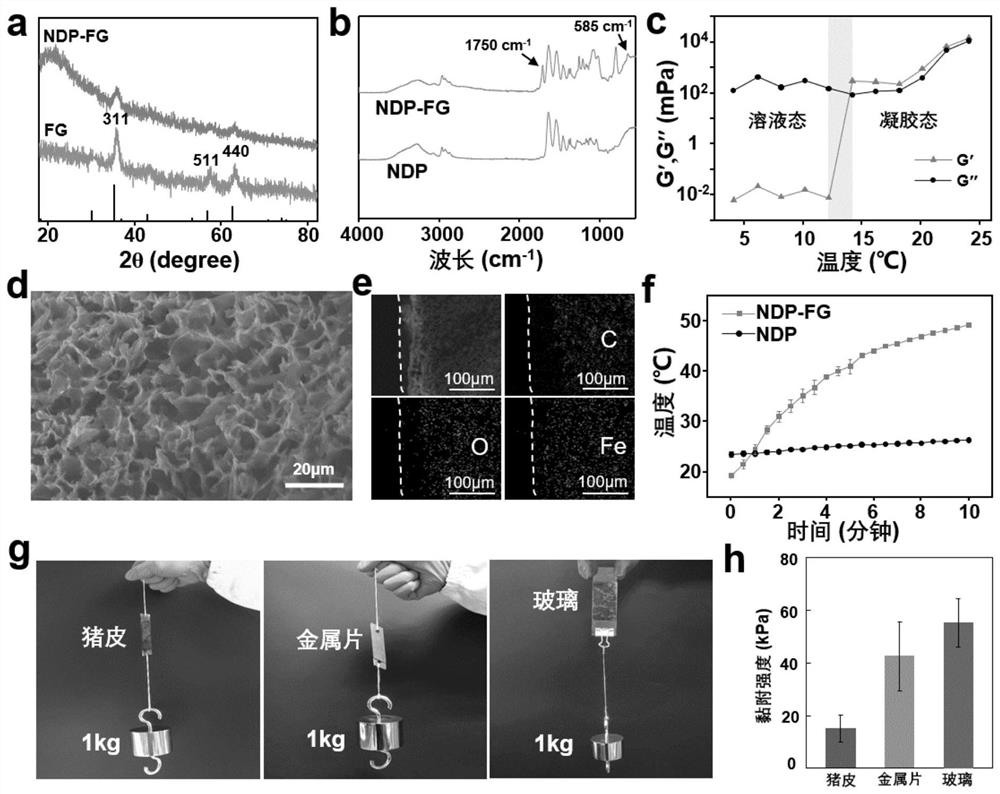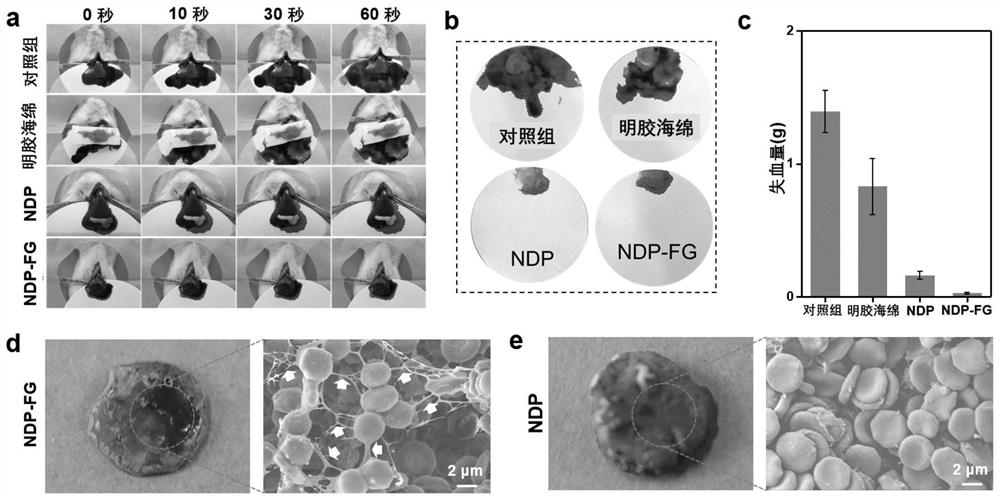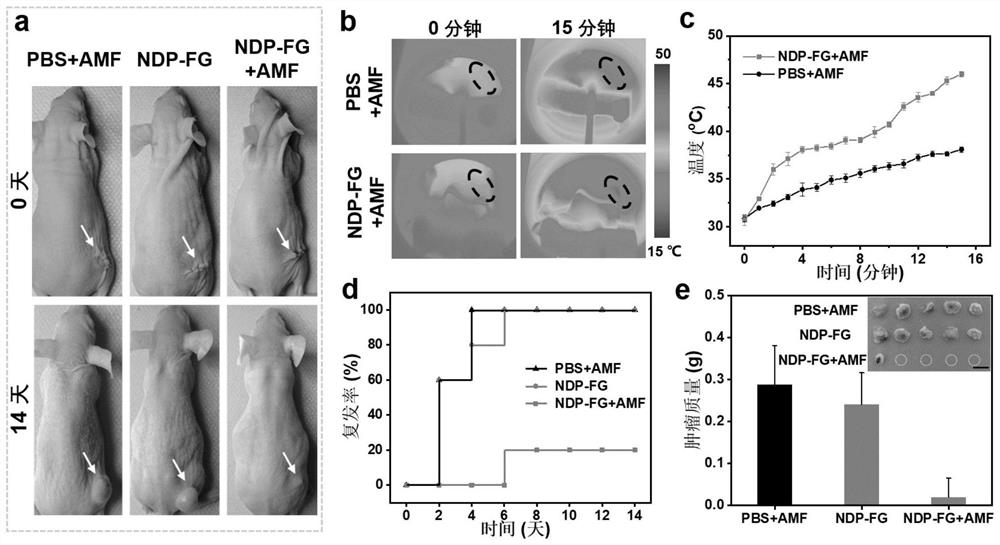Thermal response magnetic hydrogel as well as preparation method and application thereof
A heat-responsive, magnetic water technology, applied in the field of magnetic materials, can solve the problems of embolization therapy for liver cancer, single function of hydrogel materials, and insufficient adhesion performance, and achieve high clinical and market application potential. Excellent performance and stable structure
- Summary
- Abstract
- Description
- Claims
- Application Information
AI Technical Summary
Problems solved by technology
Method used
Image
Examples
Embodiment 1
[0037] The present embodiment carries out the preparation of thermally responsive magnetic hydrogel according to the following steps:
[0038] Step 1: Dissolve 1.5g polyethylene glycol (Mw=4000) and 1g triethylamine in 20mL dichloromethane, pass argon protection, and transfer 1.5g 4-cyano-4-(phenylcarbonylthio) Thio)valeric acid-succinimide ester was dissolved in 10 mL of dichloromethane, added dropwise to the above solution through a dropping funnel, the solution was stirred at room temperature for 24 hours, the resulting product was settled in diethyl ether three times, after vacuum drying Obtain macromolecular chain transfer agent;
[0039] Step 2: Dissolve 0.1 g of the macromolecular chain transfer agent obtained in Step 1 in 5 mL of 1,4-dioxane, put it into a polymerization bottle, and then add 5 g of N-isopropylacrylamide and 2 g of acrylic acid -N-succinimidyl ester, 0.1 g azobisisobutyronitrile, fully dissolved, protected by argon, reacted at 78°C for 24 hours after t...
Embodiment 2
[0055] In this example, a thermally responsive magnetic hydrogel that can be used for multimodal treatment of liver cancer is prepared according to the following steps:
[0056]Step 1: Dissolve 10 g of polyethylene glycol (Mw=4000) and 5 g of triethylamine in 100 mL of dichloromethane, and protect with argon. 40 g of 4-cyano-4-(phenylcarbonylthiothio)valeric acid-succinimide ester was dissolved in 10 mL of dichloromethane, added dropwise to the above solution through a dropping funnel, and the solution was stirred at room temperature In 12 hours, the obtained product was precipitated three times in diethyl ether, and the macromolecular chain transfer agent was obtained after vacuum drying;
[0057] Step 2: Dissolve 0.2g of the macromolecular chain transfer agent obtained in Step 1 in 5mL of 1,4-dioxane, put it into a polymerization bottle, and then add 10g of N-propylacrylamide and 50g of acrylic acid -N-succinimidyl ester, 0.1 benzoyl peroxide, etc., fully dissolved, protect...
Embodiment 3
[0064] In this example, the thermally responsive magnetic hydrogel was prepared as follows:
[0065] Step 1: Dissolve 1.5 g of polyethylene glycol (Mw=4000) and 1 g of triethylamine in 20 mL of dichloromethane, and protect with argon. 1.5 g of 4-cyano-4-(phenylcarbonylthiothio)valeric acid-succinimide ester was dissolved in 10 mL of dichloromethane, added dropwise to the above solution through a dropping funnel, and the solution was allowed to cool at room temperature After stirring for 24 hours, the resulting product was precipitated three times in diethyl ether, and the macromolecular chain transfer agent was obtained after vacuum drying;
[0066] Step 2: Dissolve 0.1 g of the macromolecular chain transfer agent obtained in Step 1 in 5 mL of 1,4-dioxane, put it into a polymerization bottle, and then add 5 g of N-isopropylacrylamide, 2 g of acrylic acid- N-succinimide ester and 0.1 g azobisisobutyronitrile were fully dissolved, protected by argon, and reacted at 40°C for 48 ...
PUM
 Login to View More
Login to View More Abstract
Description
Claims
Application Information
 Login to View More
Login to View More - R&D
- Intellectual Property
- Life Sciences
- Materials
- Tech Scout
- Unparalleled Data Quality
- Higher Quality Content
- 60% Fewer Hallucinations
Browse by: Latest US Patents, China's latest patents, Technical Efficacy Thesaurus, Application Domain, Technology Topic, Popular Technical Reports.
© 2025 PatSnap. All rights reserved.Legal|Privacy policy|Modern Slavery Act Transparency Statement|Sitemap|About US| Contact US: help@patsnap.com



